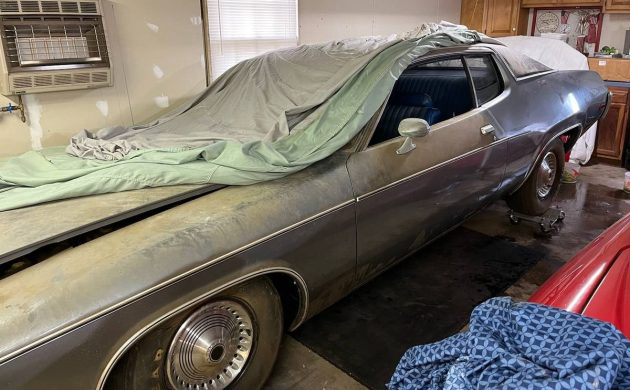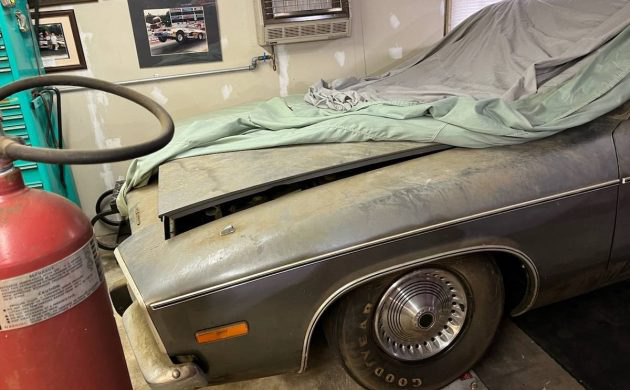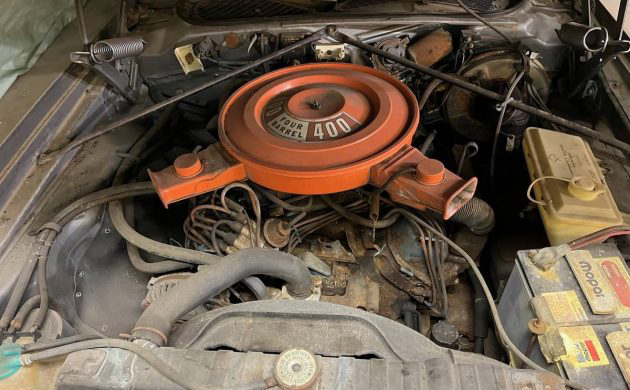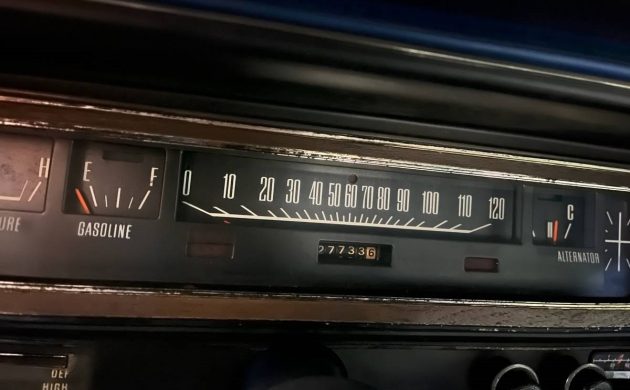27k Mile Garage Find: 1973 Plymouth Satellite Sebring Plus
Launched in 1965, Satellite was the top trim level of the mid-size Plymouth Belvedere. It became the moniker for the series in 1971 and held that role through 1974 after which the Fury name moved over to the B-bodies. This 1973 Satellite Sebring Plus may only have 27,000 miles and looks to have been kept covered in an air-conditioned garage for many years. From Honey Book, Pennsylvania, we don’t know the running condition of the vehicle, any of its history, or even the asking price, here on craigslist. Our thanks to Anthony M. for this undercover tip!
In an unusual move when Chrysler’s intermediates were redesigned in 1971, different sheet metal was deployed depending on the body style. Sedans and station wagons rode on a 117-inch wheelbase while the coupes sat on 115 with different front clips. The rework borrowed from the “fuselage” look that had been developed earlier for the full-size models. Changes were minimal for the first two years, with the front-end changing in ’73 for the 2-door Satellites. That year, the upscale Sebring Plus, only available as a coupe (personal luxury car competitor?), saw production of 21,400 units.
Little to no story is offered on this car. Instead, the seller says to call for details which is likely going to generate more tire-kickers than most of us would have time for. The claimed 27,000 miles may be correct given that a Mopar-branded battery is under the hood. That could be the original battery, or the owner went to Plymouth for a new one when the first one expired. The big unknown is why would the auto be retired for an extended beyond and then wait 50 years to resurface.
Limited photos are provided, and the car is partially covered. So, we can’t gauge the condition of the body, paint, or interior. The vehicle appears to be finished in Dark Metallic Green, flanked by a matching vinyl roof. There’s a 400 cubic inch V8 under the hood, replacing the former 383 that filled that need in the 1960s and early 1970s. Since the seller doesn’t say if the car runs, we assume it does not or what it might get to change that besides a new battery.
Auctions Ending Soon
 2002 Subaru Impreza WRXBid Now2 days$333
2002 Subaru Impreza WRXBid Now2 days$333
 1975 Chevrolet Corvette ConvertibleBid Now2 days$4,000
1975 Chevrolet Corvette ConvertibleBid Now2 days$4,000
 1964 Ford F-100 Camper CustomBid Now3 days$2,000
1964 Ford F-100 Camper CustomBid Now3 days$2,000
 2006 Jeep Wrangler SportBid Now4 days$10,500
2006 Jeep Wrangler SportBid Now4 days$10,500
 1974 Datsun 260ZBid Now6 days$200
1974 Datsun 260ZBid Now6 days$200





Comments
For to have been kept under a cover, and in an air conditioned garage, this car is certainly dusty. Not enough details or information provided, and the attitude projected by the Craigslist ad would be a turn off. It may be one of those “honey, I’m trying to sell it, but no one’s answering my ad” deals. I didn’t care for the reworked 73 body, especially as to me, the vinyl top looked like an ill fitting toupee!
I place vinyl roofs in the same category as vinyl siding on a house. Both are crimes against autodom and architecture, respectively! Both are trying to be something they aren’t, and failing miserably. The vinyl siding is trying to look like wood clapboards, and a vinyl roof is trying to look like a convertible. Neither fake is the least bit convincing.
I do wonder what Robert Atkinson Sr. had to say about those things!
400 is a GM engine
GM had several, Chevrolet, Pontiac, Buick and Oldsmobile, which were all different. Don’t forget Ford offered one too.
Steve R
The 400 was introduced in `72.
https://www.allpar.com/threads/the-400-v8-final-mopar-big-block-engine.229879/
https://en.wikipedia.org/wiki/Chrysler_B_engine
OMG really dude?
Nah, I thought it the 3800 Buick v6!
Do you not know Chrysler and Ford also produced 400 cubic inch engines.
Hahaha, sometimes it best to not respond when you don’t know your butt from a hole in the ground.
Yes, GM had a 400!
🤦🏻♂️
Rusty bumpers. Weak or broken torsion bars. Dirt everywhere. I’m going with 127K. A Plus with hubcaps?? Sooo many questions.
BTW that’s a heater, not A/C.
Maybe front shock towers rotted away? I had something like that happen to a duster I bought when 17 years old, was a big job they said, I junked it. Car looked great and ran well otherwise.
It’s a Mopar 400…it’s the 383 with a 4.32 bore..is actually 396 cubes but that number was made too famous by Chevy…The reason for changing the bore on the 383 was to standardize the blocks and save money..mopar bled money like a wet napkin for decades.
Last night there was at least 5 comments,this morning only 2,what up with that??
Welcome to censorship in all aspects of life. It’s a 1984 thing. I didn’t see what the other comments said but if someone found those words to be “damaging” or “emotionally violent” then they get “cancelled.”
This one, most assuredly will also be erased.
This car is not a Sebring “Plus”, just a Sebring. The Plus meant rallye gauges and high back seats, either buckets or split bench with armrest. And yes, the 400 replaced the 383 in 1972.
PLUS…it should have lower body side trim in a different color.
Only the ’72 Sebrings and Pluses had trim along the lower body character line and, on Pluses, argent paint below it.
Yer they usually was silver below the side moldings and nameplate on front quarter Sebring with a red Plus below it
You are correct it is a plain Sebring. I had a 1973 Sebring Plus with the 400 engine and the gauges were “rallye” or circular in a wood tone dash. I had the high back buckets. Mine was green paint with a white vinyl roof ( a bear to keep clean) and the green seats.
Also by the looks of the engine/compartment and wear on dash/gauge trim I’d say this car has 127000. Cool car nonetheless!
A definite maybe here. She might clean up really nicely, or she could become a very deep money pit, it’s so hard to tell with such limited information from the seller. I’m guessing that you will need a full fuel system flush, including removing and replacing or cleaning the fuel tank, along with a carburetor rebuild, and a new battery just to get things moving again, followed by a new or re-cored radiator and a new heater core to keep the temperature under control. Just make sure to turn the engine over by hand first, to make sure that the pistons haven’t rusted stuck in their bores. Hot tanking the block might be a good idea, to flush any corrosion out of the coolant passages and oil galleries, but that can wait until you can get the thing running and assess the health of the engine more deeply with a compression test or cylinder leak down test.
Once you get it running, you’ll probably be rebuilding the rest of the driveline (transmission, u-joints and differential), or at a minimum, replacing all of the fluids and filters in same, along with new brakes and tires. If the brake fluid has crystalized, add a new master cylinder and vacuum booster to the list. The front suspension will probably need rebuilding, as all of the bushings have dry rotted, and the shock absorbers are likely toast.
Get through all of that, along with a good wash & wax, and you can really see what you have. If the body and interior are solid, congratulations! You’ve scored classic driver for relatively short money. If the inspection uncovers any major flaws, such as engine or transmission issues that force a rebuild or replacement, or an attack of the dreaded “tin worm”, goodbye driver, hello money pit! I figure it will take between $500 and $1000 just to get the car running well enough for a detailed assessment of the mechanical condition of the major systems. If a visual inspection reveals any major body rust, run, do not walk to the nearest exit!
Sounds like good advice you must have done this a few times
That, and the same thing happens if I don’t put fuel stabilizer in my lawn mower or snow blower for off-season storage! Modern gasoline, with the ethanol in it, doesn’t last nearly as long as it used to, so I learned my lesson the hard way. Rebuilding a carburetor clogged with varnish teaches you that lesson quickly, LOL! Rubber ages with time, regardless of mileage, so for any old car greater than ten (10) years old, all of the rubber bits are on their way out anyway. Oil, transmission fluid and power steering fluid all collect water from condensation if the car hasn’t been run in a while, so all of those fluids will have to be changed, and the parts checked for internal corrosion from water sitting in them. Driving the car heats it up and drives the water out.
Based on the location – even if it was driven for one salty winter, the body will have corrosion in at least the top of the front fenders and bottoms of all fenders.
I had a 73 Sebring Plus, this is just a Sebring.
My Sebring Plus had a plain jane 318 with A/C, bucket seats, console , floor shift, deluxe interior (Faux wood grain etc.LOL) and last but not least, the rallye gauge package.
Special wheels, Bob?
BTW, a “sleeper” back in the day lol.. no one would think a plain jane Sebring would be running a 400 LOL
The 73 400 had less power than a 70 225 slant 6! The real noticeable power loss was the 71 383 vs the 73 400, I had one of these in a 4 door that had a 400 4bbl and it ran mid 18s in the 1/4 mile but sounded like a mad Grizzly with that breather lid flipped over and wasn’t as big a slouch from a 30 roll, but compared to the 71 383 it was a real pig! If I owned this car it would get a 68-70 440 upgrade real quick! Hey, if you’re gonna be a Bear, be a Grizzly! Same thing goes when owning a nice 2 dr Mopar, if you’re gonna spend the money making it cool, spend BIG MONEY and make it Brutal Too!
A 440 crank in that 400 is a proven combo. The early 72-74 400s had the most stout block architecture of any big block making them excellent choices for stroker builds.
I had a ’72 with this setup and it was fast! (And furious)
Police hp 275 hp at best. Kinda doubt this plain Jane has that 400 in it. Most of the time any mopar I have encountered and I’m a mopar guy where the front end is sitting that low there’s 3 possibilities for it. 1 the torsion bars have been lowered . 2 car originally had a 6 or small v8 and dropped In a big block. Or 3 the bars are broken or torsion box’s rotted. I’m thinking most likely #3. Also why no price?
I would like to see the VIN, big block, AM/FM and no AC are an unusual combination for a Sebring.
Usually high when no price advertised a lot of dealers do that
absolutely NOT dark green, this little sweetheart is dark charcoal met.
Satellite Sebring-Plus 400 V8 4-bbl TorqueFlite (aut. 3) in 1973, the model with 2-door hardtop coupe body and V-8 6555 cm3 / 400 cui, 194 kW / 264 PS / 260 hp (SAE net) of power, 454 Nm / 335 lb-ft of torque, 3-speed automatic powertrain offered since September 1972 for North America. According to the ProfessCars™ estimation, this Plymouth would accelerate 0-60 mph in 7.5 sec, 0-100 km/h in 7.9 sec, 0-200 km/h in 44.8 sec and a quarter mile time is 15.5 sec.(Courtesy of Hagerty.com)
I scrapped a 73 Sebring Plus in the early 80s. Green (F8) with a white canopy top, green bucket seats with power windows and factory crank sunroof. No kidding. 318 auto trans with A/C. Oh, and “Magnum 500” wheels. Car was a project that someone gave up on. Pretty straight and clean but I already had other projects and wasn’t interested. Maybe if had been equipped with the 400 I would have felt differently. I still have the fender tag.